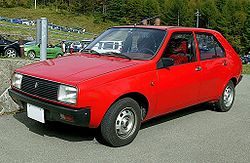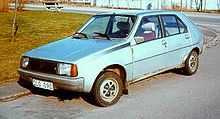Renault 14
| Renault | |
|---|---|
|
Renault 14 (1976-1979)
|
|
| 14th | |
| Production period: | 1976-1982 |
| Class : | Compact class |
| Body versions : | Station wagon |
| Engines: |
Petrol engines : 1.2-1.4 liters (42-52 kW) |
| Length: | 4020 mm |
| Width: | 1629 mm |
| Height: | 1400 mm |
| Wheelbase : | 2530-2560 mm |
| Empty weight : | 865 kg |
| successor | Renault 9/11 |
The Renault 14 - R14 for short - was a compact class car that was offered by the French car manufacturer Renault between May 1976 and December 1982 and built in the Renault plant in Douai in northern France and in the Belgian plant of Renault Industrie Belgique in Haren . The R14 was Renault's first model in the so-called Golf class, although the vehicle was 30 cm longer than the VW Golf I at the time .
Vehicle development
The Renault 14 did not have an immediate forerunner in the Renault range. It was longer than the Renault 6 hatchback sedan , a small car on the chassis of the Renault 4 , but 30 cm shorter than the Renault 12 notchback sedan with a larger interior and trunk .
The R14 as a hatchback sedan with a large tailgate and thus a variable trunk followed the now typical body concept of the compact class, which was introduced with the Autobianchi Primula and successfully continued with models such as the Austin 1100 Countryman or the Simca 1100 and others.
Unlike the VW Golf or other competitors, the R14 was only offered with five doors.
technology
The Renault 14 was the result of the cooperation with Peugeot. Most of the technical components of the R14 came from Peugeot, the body and equipment from Renault. The R14 was to remain the only model that was developed in this way.
The Renault 14 was powered by a light-alloy engine from the Peugeot 104 that was enlarged to 1.2 l and was installed at a steep incline at the front. There was space for the spare wheel above the engine. The gearbox under the engine in the oil pan was lubricated by engine oil. The chassis with MacPherson struts at the front and trailing arms at the rear stood out from most of its competitors thanks to its elaborate design. The passive safety was a high for this time and vehicle class level, crash tests were necessary with side impact protection in the doors and rigid passenger cell, including quite complex.
The advantages of the vehicle were its above-average driving comfort, its high level of driving safety and its quiet engine running. For a car of its class and of its time, the interior, space and seating comfort were exemplary.
The body, however, suffered from inadequate rust prevention. At the start of production, the processing quality and reliability were also not at the level of quality offered by the competition.
With further power and equipment variants (1979: 1.4-l engine, 1980: R14 TS) and a slight visual revision in September 1979, Renault tried to open up further customer groups with the compact car.
Early end
After just over six years of construction and almost a million vehicles produced, production of the Renault 14 ended in December 1982.
Its low popularity and its susceptibility to rust have ensured that even in France the R14 has almost completely disappeared from the streets today. In addition, marketing errors and quality deficiencies prevented a greater success of this visually idiosyncratic, conceptually quite competitive car, which in its typically French manner combined stylistic extravagance with pragmatic utility.
As a successor, a compact car with a notchback was introduced in September 1981 with the Renault 9 . In May 1983 a direct replacement for the R14 appeared under the name Renault 11 , which represented the hatchback version of the R9 with three or five doors.
design
Formally, the R14, with its deliberately rounded curves, stood out clearly from the design of its competitors and also from the Renault design, which had been cultivated up until then; only with the successful small car Renault 5 existed a certain relationship. An interesting detail is the line of the side windows below the bonnet end, optically compensated by the side mirror placed there.
The unusual body with the gently sloping side line offered numerous practical advantages; the rounded, arched shape ensured good economy of space, and it was comparatively aerodynamic. In the first driving report of the ADAC Motorwelt, their tester JG Stratmann commented on criticism of the design with the note, "In Billancourt they are now throwing the curve ruler into the corner".
The pear-shaped advertising campaign
Despite the good concept of the Renault 14, its design rather scared off the public, especially as Renault in France advertised the car in large advertisements that showed a horizontal bulb. The campaign launched by Publicis in 1977 also failed. Potential customers did not see the pear as an allusion to an organic design, but as evidence of a lack of solidity and seriousness.
As a consequence, the term “pear” (poire) remained the unflattering nickname for the R14 in France.



